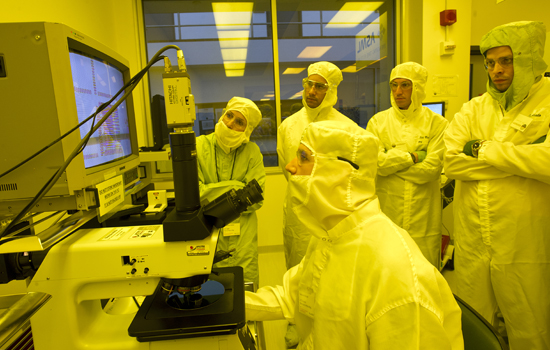Our watershed moment: Becoming a ‘Doctoral University’
A. Sue Weisler
RIT has seven doctoral programs, including microsystems engineering shown here.
RIT’s history is fascinating.
Our founding dates back to 1829 when Col. Nathaniel Rochester started the Athenaeum, an association “for the purpose of cultivating and promoting literature, science and the arts.” The Athenaeum and Mechanics Institute merged in 1891, bringing under one roof cultural education and practical technical training. And it wasn’t until 1955 that we granted our first Bachelor of Science degree.
This year marks another milestone: RIT is now considered a “doctoral university” by the leading national classification of U.S. colleges and universities. The Carnegie Classification of Institutions of Higher Education has changed RIT from “Masters – Comprehensive” to a “Doctoral University.” This change occurs when a university grants more than 20 Ph.D. degrees per year, a figure that RIT has exceeded in recent years. In May 2015, RIT awarded 33 doctoral degrees in seven Ph.D. programs, the most in our history.
The movement of RIT into the ranks of the nation’s finest colleges and universities is a remarkable story as we take on a more national and international profile.
The Carnegie Classification has been the leading framework for recognizing and describing institutional diversity in U.S. higher education for the past 46 years. The Carnegie Commission on Higher Education developed a classification of colleges and universities to support its program of research and policy analysis.
The Carnegie Classification change also means that RIT will soon be ranked among the “National Universities” by U.S. News & World Report, rather than among the top “Regional Universities—North” as has been the case since the magazine began its annual rankings in 1983.
Our ascent into research began in 1999 when we began our first doctoral program in imaging science, the first in the nation. In the 2000s, we added six more in the areas of astrophysics, color science, computing and information sciences, engineering, microsystems engineering and sustainability. Several interdisciplinary doctoral programs are in the planning stages.
For the first time in the university’s 187-year history, the word “research” was incorporated into the vision statement of RIT’s 2015-2025 strategic plan “Greatness Through Difference.” The vision statement reads: “RIT will be a great world university whose academic portfolio, research agenda, and educational model align with the shifting needs of a complex planet.”
Our sponsored research grew by 18 percent in 2015, reaching a record $62 million in funding. We received 356 new awards from a variety of state, federal, corporate and foundation sponsors. And in the coming year, we plan to do more in areas like cybersecurity, health care technology, photonics and unmanned aerial science.
We are also celebrating the amazing accomplishments of our Center for Computational Relativity and Gravitation, which was a part of the monumental day in the world of science announced in February. Our researches were among the team that proved Albert Einstein’s General Theory of Relativity was right!
But as we pivot in this research direction, we must never forget our roots. We will remain a student-centered university where the success of all our students continues to be our core mission.
Yours in Tiger pride,
Bill Destler, President
www.rit.edu/president










